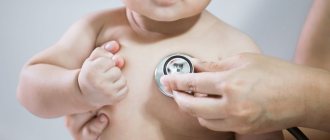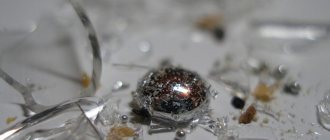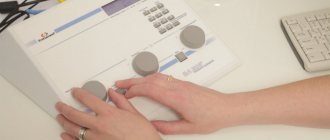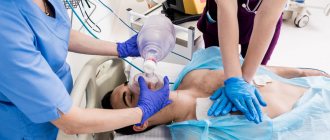According to statistics, up to 80% of children suffer from perhaps the most common parasitic disease – enterobiasis.
Cost of testing for enterobiasis (scraping for pinworm eggs): 300 rubles.
Hygienic skills in children, as a rule, are not yet sufficiently developed, so it is during childhood that the incidence of helminthic infestations peaks. Most often, enterobiasis affects young children attending preschool institutions.
The causative agent is the pinworm (Enterobius vermicularis). This is a small helminth that lives in the large intestine. The source of infection is a sick person. The female pinworm, usually at night, crawls out of the rectum and lays eggs in the folds near the anus.
At the same time, children are bothered by itching in the perianal area, which can have varying intensity and duration, depending on the degree of the disease and the number of pinworms. Scratching the anus by a patient leads to abrasions on the skin, secondary bacterial infection, and dermatitis, which aggravates the course of the disease. Also, parasite eggs accumulate under the child’s nails, which contributes to the spread of infection, and if swallowed again, it ensures re-infection (reinvasion).
Girls may experience a specific complication of enterobiasis - vulvovaginitis due to the penetration of pinworms into the genital tract.
Abdominal pain is a common symptom of enterobiasis. Sometimes acute abdominal pain may be the reason to seek surgical help.
Allergization of the body and suppression of the immune response is a common pathological effect inherent in all helminths.
Hand washing and short-cut nails in children are the two most basic rules for preventing enterobiasis.
What is enterobiasis
Enterobiasis is a parasitic disease (helminthiasis) that causes intestinal dysfunction and itching in the anus. Its causative agent is pinworms - small worms up to 13 mm long. Infection occurs when their eggs enter the body: through food and water, but more often due to poor hand hygiene (it’s not for nothing that enterobiasis is called “the disease of unwashed hands”). Pinworms live in the cecum, the lower part of the small intestine, and the beginning of the colon.
The disease develops as follows:
- The eggs enter the human gastrointestinal tract, where they hatch into larvae.
- Sexually mature individuals move to the ileum, where they mate, then the males die, and many eggs develop inside the females - their number in the body of one pinworm can reach 20,000.
- Females lay eggs on the perianal folds (skin around the anus) of a person (this happens at night).
The lifespan of pinworms is short - only 3-4 weeks. After laying eggs they die. Theoretically, after their death, self-healing from enterobiasis can occur. In practice, this happens in isolated cases, since pinworm eggs continue to regularly enter the body. This happens as follows: a person, feeling itching during sleep, begins to comb areas of the skin. Pinworm eggs get under his nails, from where they are then transferred to surrounding objects, bedding, and clothing. This is how a person continues to infect both himself and those around him.
Important! Enterobiasis most often occurs in children's groups - kindergartens, junior grades of schools. But pinworms can also occur in adults. If you have symptoms of the disease, you must be tested for enterobiasis.
Pinworms harm the human body in the following ways:
- Significantly reduce the quality of life - in the evenings and at night the patient feels severe itching in the anus, this gives him anxiety, he does not get enough sleep, becomes irritable, his concentration and ability to work suffer.
- They “appropriate” useful substances - vitamins, minerals, but as a result, a person does not receive enough of them, which can result in disturbances in metabolic processes.
- They contribute to the development of genital infections in women - constant injury to the mucous membrane creates a favorable environment for the proliferation of fungi and bacteria.
- They provoke intoxication and allergies - their waste products “contaminate” the human body.
Important! To identify the disease, it is recommended to take a scraping rather than a regular stool sample. This is due to the fact that pinworms rarely lay eggs in the intestines, so stool analysis for enterobiasis will be uninformative. The material for research must be taken from the perianal folds.
Self-infection and retroinfection
The first human infection occurs from another “host” of pinworms. Subsequent methods usually come down to self-infection. If hygiene rules are not followed and treatment is not carried out, the cycle from laying eggs to ingesting them and laying new eggs can last a lifetime.
In 70% of those infected, the first symptoms occur when the females emerge from the anus to lay eggs. Laying occurs at night and is accompanied by itching of varying intensity in the perianal area. A person, especially a child, can itch in their sleep without even knowing it.
In the morning, if a person does not wash his face and immediately sits down to breakfast, eggs from the fingers and from under the nails will fall onto the food, and with it into the gastrointestinal tract. You can simply touch your face - and this is enough for infection.
You can transfer eggs from the anus to the mouth after visiting the toilet. If eggs get on your fingers and your hands are not washed, the eggs will sooner or later end up inside the person along with the food.
If basic hygiene is not observed, pinworm larvae can hatch from eggs and on the mucous membrane of the anus. They migrate up the intestines where they grow and develop. This mechanism of infection is called retroinfection.
Scraping for enterobiasis: when to take it
Tests for enterobiasis can be divided into 3 categories:
- preventive;
- to prevent epidemics;
- according to indications.
The patient undergoes preventive testing at his own request. It is recommended to do this annually.
Important! You should definitely get tested for enterobiasis after contact with infected people. The incubation period of the disease is 14 days. That is, the study is carried out no earlier than 2 weeks after contact with an infected person.
Tests carried out to prevent epidemics are taken by both adults and children to obtain certificates. Adults may need them:
- when applying for a job (for example, in a school or kindergarten);
- before visiting the pool;
- before admission to hospital or surgery;
- for registration of a medical record when working with products.
Children undergo the following study:
- before starting kindergarten or school;
- before going to camp;
- before visiting sports sections.
According to indications, tests are taken if the following symptoms are present:
- Severe itching in the anus - in the evening and at night; in women it can also be observed throughout the entire perineum (since pinworms can crawl into the vagina).
- Stomach ache.
- Loose stools mixed with mucus - enterobiasis causes intestinal disorders.
- Bloating.
- Irritability.
- Apathy.
- Fast fatiguability.
- Headache.
- Allergic skin reactions - rash, redness.
Important! Since enterobiasis significantly reduces immunity, as a result of which the patient may often suffer from colds and infectious diseases, it is necessary to identify and eliminate the pathology as early as possible.
Types of studied material and collection rules
To study enterobiasis, patches, scrapings, smears from the skin in the perianal area are used, and, if necessary, skin scrapings from under the nails. Analysis of this biomaterial has the greatest sensitivity and allows you to make a diagnosis with confidence.
Feces are rarely used for analysis, because pinworms practically do not lay eggs in the intestines - such biomaterial is not informative. Feces make it possible to diagnose enterobiasis during a long course of the disease and mass intestinal invasion by pinworms. In this case, helminths are visible on the surface of the feces with a simple macroscopic examination.
How the research works
How to get tested for enterobiasis? First, a scraping is performed, and the resulting biomaterial is sent for analysis. The patient then receives the results in person or by email.
Will I be able to get tested at home?
At home, collection of material can be done in two ways:
- Do the scraping yourself.
- Order a home visit from the Otradnoye Polyclinic.
In the first case, you need to stock up in advance with a special kit for taking samples for enterobiasis. It includes a cotton swab soaked in glycerin and a special container or adhesive tape and a glass slide. You can purchase such a kit at a pharmacy or directly at a clinic.
Scraping is carried out in the morning, after waking up, right in bed:
- A cotton swab is passed over the skin around the anus.
- Place the stick in the container and close it.
- Before leaving the house, store the scraping at a temperature of +4-8 degrees.
- The test is delivered to the laboratory within 2 hours.
When using a glass slide, the procedure will be as follows (also after waking up):
- The tape is removed from the glass.
- Glue it to the skin around the anus for a few seconds.
- Place the tape on the glass.
- The glass is placed in a bag and delivered to the laboratory.
Important! It is recommended to do scraping using any method while wearing medical gloves.
If you order an at-home test for enterobiasis at the Otradnoe Polyclinic, the nurse will come with everything you need and will independently take the scraping to the laboratory.
Scraping for enterobiasis: how to take it from adults
Adult patients need to come to the treatment room in the morning to take the material, without performing hygienic procedures. The patient will be asked to expose their lower body, bend over and spread their buttocks with their hands. The nurse will use a glass rod to make a scraping. The material will then be sent to the laboratory.
Scraping for enterobiasis: how to take it from children
A test for enterobiasis is required for a kindergarten, school or sports section: how to give a scraping to a child? Exactly the same as for an adult. Perhaps parents are advised to psychologically prepare their child in advance: the procedure is absolutely painless, but if the child is undergoing it for the first time, it may cause him anxiety.
The procedure for collecting material is no different from that in adults.
References
1. Clinical recommendations (treatment protocol) for providing medical care to children with enterobiasis. FSBI NIIDI FMBA of Russia, 2014.
2. “MUK 4.2.3145-13. 4.2. Control methods. Biological and microbiological factors. Laboratory diagnosis of helminthiasis and protozoa. Guidelines" (approved by Rospotrebnadzor on November 26, 2013).
3. R. S. Arakelyan, N. A. Sergeeva, V. Sh. Sangadzhieva, O. V. Konnova, A. N. Zagina, A. A. Obukhova. Clinical and epidemiological aspects of the course of enterobiasis in school-age children. Children's infections. 2018; 17(1): 50-53.
4. Infectious diseases: national guidelines / Ed. N.D. Yushchuka, Yu.Ya. Vengerova - M.: GEOTAR-Media, 2010. - 1056 p.
5. V.P.Sergeev Atlas of clinical parasitology and tropical medicine. Authors Academy. Partnership of scientific publications KMK, 2010
How long to wait for the result of a scraping for enterobiasis?
Typically, the patient needs the results of such studies urgently. Therefore, many people are concerned about how much testing for enterobiasis is done. At the Otradnoe Polyclinic you will be able to receive the results of the study the very next day.
Please note that the results have an “expiration date”. You have been tested for enterobiasis: how long will it be valid? Its validity period is 10 days. That is, if you did a study for an institution, then you will need to deliver the results to the place of request within 10 days after the analysis.
Analysis for enterobiasis: price
At the Otradnoye Polyclinic, testing for enterobiasis is quite inexpensive - a few hundred rubles. In some cases, to maximize the reliability of the results, it is necessary to complete the study several times.
Diagnostic methods and interpretation of results
The most common diagnosis of enterobiasis is the microscopic detection of helminth eggs in smears, scrapings of subungual contents and skin in the perianal area, and patches from the surface of the perianal area.
Normally, there should be no eggs in the biomaterial. If at least 1 viable egg or remains of a worm are found, a positive diagnosis is made.
To be sure of sterility from pinworms or helminth infestation, you need to undergo at least 3 studies at intervals announced by the doctor.
Treatment methods for detecting pinworms in a child
To treat enterobiasis, the doctor prescribes anthelmintic drugs. The dosage is determined according to the age and weight of the patient. It must be remembered that all these drugs are highly toxic and can cause adverse reactions. Pediatricians do not recommend choosing medications without consulting a specialist.
If a child is diagnosed with pinworms, then all family members need to undergo treatment. If there is a pet living in the house, it is also necessary to purchase anti-worm medication for it.
During treatment, it is also necessary to take sorbents, since anthelmintic drugs do not remove parasites from the body.
An effective regimen for taking medications and necessary procedures is prescribed by the doctor.
A number of hygiene procedures for the home are necessary:
- after the end of treatment, change the linen by ironing it with a hot iron;
- boil or wash the toys in hot water with added salt;
- Regularly carry out wet cleaning at home.
Content
- The causative agent of parasitic infection is pinworm
- Causes of pinworm infection
- What complications does the disease cause?
- Symptoms of the disease Acute period
- Chronic stage
Enterobiasis is an infection of the body with helminths - pinworms. Young children are at risk, but children of other ages can also be infected.






